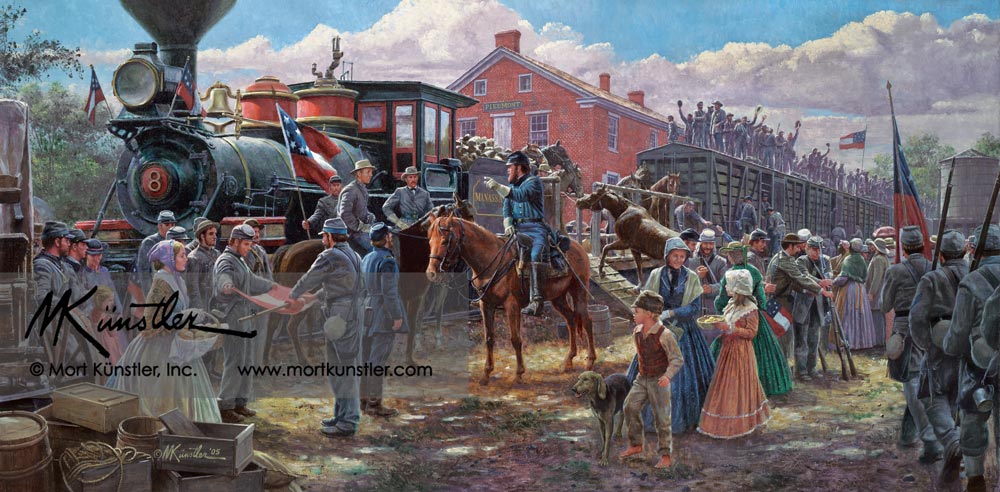Künstler
Victory Rode the Rails
Victory Rode the Rails
Couldn't load pickup availability
This is Mort Künstler limited edition print - Victory Rode the Rails. Jackson at Piedmont Station, July 19, 1861.
LIMITED EDITION PRINTS
Paper Prints
Reproduction technique: Fine offset lithography on neutral pH archival quality paper using the finest fade-resistant inks.
Each print is numbered and signed by the artist and accompanied by a Certificate of Authenticity.
Image Size: 15” x 30” • Overall size: 21” x 35”
Signed & Numbered • Edition Size: 750
Artist's Proof • Edition Size: 100
Giclée Canvas Prints
Reproduction technique: Giclées are printed with the finest archival pigmented inks on canvas.
Each print is numbered and signed by the artist and accompanied by a Certificate of Authenticity.
Size: 18” x 36”
Signed & Numbered • Edition Size: 100
Signed Artist's Proof • Edition Size: 10
Historical Information
It was like a grand holiday. Throughout the North and South in the summer of 1861, America’s young men gleefully pulled on new uniforms, shouldered “rifle-muskets” and cheerfully left for war. They would whip the Rebels in 90 days, boasted Northern recruits. One Southerner could lick ten Yankees, claimed Southern boys. Never again would Americans go to war with such an unrealistic, romantic notion. Some knew better. Brigadier General Thomas J. Jackson, an unremarkable mathematics instructor from the Virginia Military Institute, was a Mexican War veteran, and he tried hard to prepare his troops – Virginia’s First Brigade – for the reality of war.
But even Jackson’s troops went to war as if heading for a holiday picnic. As they boarded a train at Virginia's Piedmont Station – among the first troops moved to battle by rail – they encountered a boisterous celebration. Flags were flying, troops were waving and young women were passing out treats. A holiday atmosphere masked a grim reality: Many of these youngsters, like their counterparts in the North, would soon be dead or wounded in the war's first major battle at First Manassas. There, too, near the banks of an obscure creek called Bull Run, the unknown VMI officer, Thomas J. Jackson, would rally the shaken Southerners, help turn the day for the Confederacy – and emerge forever famous as General “Stonewall” Jackson.
Mort Kunstler’s Comments
Ideas for my paintings come from different sources and my newest painting, Victory Rode the Rails, is no exception. The name was inspired by the title of a fifty-year old book by George Edgar Turner. I was on my way to an appearance at Virginia’s Shenandoah University when I encountered the historic site that led me to paint Victory Rode the Rails. Bill Austin, the director of the university's History and Tourism Center, had picked me up at the airport in Washington, D.C. As we passed near the town of Delaplane, Virginia, he said he wanted to show me something interesting. We crossed some railroad tracks and stopped in front of an old brick building, now housing an antiques store. During the Civil War, Bill told me, the structure was the railroad station for the town, at that time called Piedmont Station. It was here, I learned, that Brigadier General Thomas J. Jackson and his troops boarded the train that would take them to the battle of First Manassas and everlasting fame.
What a great subject for a painting! The scene had never been painted, and I could include a building that still exists today – which I always enjoy. I consulted with award-winning historian James I. Robertson, Jr., author of the acclaimed biography, Stonewall Jackson, and with a very knowledgeable railroad historian, Courtney Wilson, who is executive director of the B & O Railroad Museum in Baltimore. And, as usual, I also studied a variety of historical works related to the subject. The more I learned, the more I wanted to paint this picture!
In the center of interest General Jackson sits on Little Sorrel, giving orders to his loyal aide, Lieutenant Colonel “Sandy” Pendleton, who is accompanied by Jackson's chief surgeon, Dr. Hunter McGuire. General Jackson, of course, still wears his blue VMI uniform. The Piedmont sign is clearly visible, and the tender of the locomotive bears the name of the Manassas Gap Railroad on its side. Overcrowding forced a large number of troops to ride atop the train cars next to where the brigade's horses are being loaded. Everything shown in the painting is supported by primary sources – eyewitness accounts, diaries, official records and memoirs. It’s quite poignant, when you think about what awaited these young men at First Manassas. Also, here is Jackson – just another officer in a pre-war blue uniform – on the verge of becoming the famous “Stonewall.” To me, it was an extraordinary event that begged to be recorded – an absolutely absorbing, colorful expression of our American heritage.
Share


Continue Shopping
See more of the Breagans' collection of manufacturers from all around the world
Subscribe to our emails
Subscribe to our mailing list for insider news, product launches, and more.

